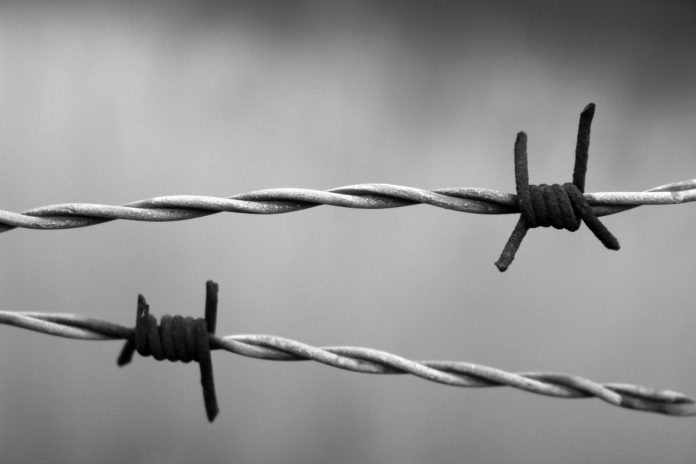Appropriately enough, probably the first patent for a form of barbed wire was issued to Leonce Grassin-Baledans in 1860 in France, where the wire became a metaphor for the stalemate between the Germans and the Allies in World War I.
However, an Illinois farmer named Joseph F. Glidden is usually given credit for inventing barbed wire due to his 1874 patent for two twisted strands of wire that held a series of double, sharpened barbs in place.
Glidden meant his wire to keep cattle in or out, and after a few pokes from the sharpened barbs, most critters learned to respect the stuff.
Forged in war
It didn’t take long for military men to realize that enemy soldiers probably had even thinner skin than most animals and that barbed wire should be just as effective against infantry and cavalry troops as on cattle.
British Army manuals of the 1880s told how to string barbed wire around perimeters and the wicked stuff was used in the Spanish-American, Boer, and Russo-Japanese wars around the turn of the 20th century.
An article in a 1918 issue of The Hardware Trade Journal tells the story under the headline: “This Cruel War’s Abuse of Our Old Friend ‘Bob Wire.'”
After telling a little about Glidden and his invention, the article goes on as follows.
“Quite naturally some animals enclosed by Glidden’s fencing gashed themselves on the barbs. Just as naturally, men and boys tried to climb over or under those fences and had their clothes and flesh torn.
“These wounds upon man and beast and the suddenness with which Glidden’s barbs halted all living things came to the attention of military men, and the barbed wire entanglement of which we now read almost every day in the war news was born.
“And it may be said right here that soldiers who have been halted by wire entanglements while making a charge say the devil never invented anything nastier.”
Strategies
Soon, military engineers from armies all over the world were hard at work designing the most effective means of deploying barbed wire, most often as a defensive measure.
Broad (30 to 100 feet wide or more), zig-zagging belts of intertwined wire in front of a defensive position interfered mightily with an enemy assault; the attacking troops had to stop and take precious time to cut their way through the wicked stuff.
Of course, during this delay, those troops were perfect targets for rifle and artillery fire, and it was here that the machine gun really came into its own, providing covering fire for barbed wire barriers.
Often the wire would be laid out to funnel masses of charging troops into kill zones that were covered by pre-aimed artillery or machine gun fire.
One account of an attack on the first day of the battle of the Somme by a Newfoundland battalion tells the story:
“Those Newfoundlanders who did reach their own wire — four well-laid belts in all — had to follow zigzag lanes between pre-cut gaps, which had been exactly pinpointed by German machine-gunners.
“Those who managed to get through these gaps had to cross five hundred yards of open ground exposed to German positions. Those few Newfoundlanders who reached the German wire were shot down as they tried to cut their way through it with their wire-cutters.”
That first day at Somme cost the British Army 19,240 soldiers killed and over 36,000 wounded — mind boggling!
Hard for horses, too
For generations, armies had relied on horse-mounted troops to reconnoiter enemy territory and to attack fortified positions en masse, providing the “shock and awe” we heard so much about a few years ago at the beginning of the campaign to oust Saddam Hussein.
Any experienced horseman knows that if one of these animals would run headlong into a mess of barbed wire it would panic and thrash around until it seriously injured itself, and its rider.
Fighting the wire
During World War I, various measures were developed to neutralize barbed wire entanglements. The Bangalore torpedo was a series of 5-foot lengths of pipe full of explosives that were screwed together and with a rounded nose at the far end were pushed under a wire entanglement. When exploded, a five-foot-wide path was cleared through the wire.
Various types of mats were thrown across the wire, allowing troops to walk over them, and instances were even reported of brave soldiers lying down across the wire and their buddies walked across their backs.
The final solution, however, was the tank; with its armored skin it was impervious to machine gun and small arms fire, and its wide tracks would ride right over and crush the wire.
Winston Churchill, who had served briefly in France as a battalion commander and was now part of the British government, said in a speech in 1914 that there must be some alternative to “chewing barbed wire in Flanders,” and he helped push forward the tank program.
Fencing people
The Great War finally ended, and “bobbed” wire returned to its peacetime duties of keeping in cattle, but wait! It wasn’t long before our barbed friend was being used extensively by the Nazis to keep the hundreds of thousands of political prisoners they rounded up during the 1930s and ’40s in concentration camps.
In this country, although they had the slightly different name of “internment camps,” thousands of Japanese-Americans were treated to the sight of barbed wire fences around themselves during the early years of World War II.
Today’s fencing
Barbed wire has had a checkered history and is still around in quantity, although it has largely fallen out of favor with farmers for containing cattle. Several high-tensile wire strands, with one or two of those strands electrified, supported on treated wooden posts has become probably the most popular cattle fencing today.
So, although the cattlemen of the “Old West” hated barbed wire, they didn’t hate it nearly as much as the Tommies, Poilus, Soldaten, and Doughboys of 100 years ago.













